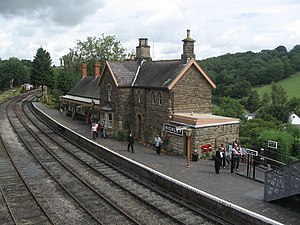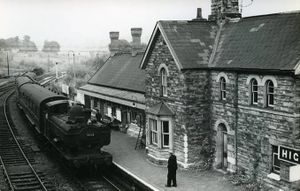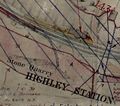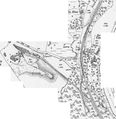| Up (towards Kidderminster) | Down (towards Bridgnorth) |
|---|---|
| Arley (2¼ miles) | Hampton Loade (2 miles) via Country Park Halt |
Highley station is the only station on the SVR with one platform (the other stops with single platforms being request halts). It also has a yard containing two sidings, controlled by Highley signal box. The yard, which is situated between the station platform and the signal box, is not signalled for through moves or passenger trains, but can be used to pass non-passenger trains with another train in the platform. On occasion a 'special' passenger train may cross with a scheduled passenger service; this is achieved by de-training the passengers from the 'special' and shunting the empty train into the yard while the passenger service passes.
The station building is constructed to the same standard as others on the line but of stone, probably quarried locally, rather than brick.
Contents
Facilities
The station has a small kiosk serving snacks and hot and cold drinks. There is also a station fund second hand bookshop in the the grounded body of GWR Horse Box 542 on the platform. A picnic area is located next to the signal box, opposite the platform.
The Engine House is situated approximately 200 yards from Highley Station, on the opposite side of the line from the platform. This can be reached via a footbridge which is located at the south end of the station. There is also a foot crossing which the public may use, except when a train is approaching or standing in the station.
Highley Station Fund
The Fund raises funds by operating the shop. It owns shares In Severn Valley Railway (Holdings) PLC and also owns BR 891054 Cattle Van and GWR 3429 Fruit D Van.
Highley history before preservation
- 1862: Highley station opened with the rest of the Severn Valley Line on 1 February, with only one platform and no facility for crossing trains. At the time the population of Highley village was only 407[1].
- 1869: The GWR approved the installation of a cattle dock.
- 1870s: Highley Colliery came into production. This resulted in a growth of both passenger and goods traffic at Highley.
- 1880: A siding was provided for a stone quarry opposite the station worked by Mr Baker of Kidderminster. It became disused following his death in about 1881.
- 1882-1883: Approval was given for the platform to be extended and additional sidings installed, resulting in the present layout. A new signal box and interlocking was installed; the Board of Trade approved these works in June 1883. Evidence of the platform extension can be seen as a change in the platform face and surface between the Highley Station Fund shop and the end of the platform.
- 1908: The General Manager recommended that additional sidings and a passing loop should be provided. In the event the work was not undertaken, as a result of which it was never possible to pass passenger trains at Highley.
- 1912-1915: Approval was given for construction of a footbridge, which was a steel lattice-girder structure of two spans. The bridge was reluctantly deemed beyond economic repair and demolished by the SVR in 1974. It was situated in the same location as the current footbridge which dates from 2009.
- 1921: The population of Highley had reached 1,985, with at least 500 employed at the colliery. Over the following years passenger numbers remained high while beginning to fall elsewhere on the line; during the 1930s Highley averaged 20,000 ticket sales per year which exceeded both Stourport and Bridgnorth.
- 1963: Through passenger services ceased on 9 September, with through freight services ending at the end of November.
| Passenger Traffic | Freight Traffic | |||||
|---|---|---|---|---|---|---|
| Year | Tickets issued | Parcels despatched | Revenue (£) | Tons received & despatched | Revenue (£) | Total revenue (£) |
| 1903 | 17,559 | 3,247 | 1,185 | 140,939 | 24,372 | 25,557 |
| 1913 | 29,030 | 7,308 | 2,515 | 219,271 | 32,774 | 35,289 |
| 1923 | 22,234 | 4,873 | 2,838 | 175,115 | 41,695 | 44,533 |
| 1933 | 21,548 | 6,237 | 1,877 | 177,543 | 24,932 | 26,809 |
| 1938 | 21,335 | 6,584 | 1,606 | 154,202 | 23,128 | 24,734 |
Historic maps of Highley Station and mine
- GWR plan circa 1880 showing the station
- Detail from the GWR plan showing the Stone Quarry siding
- 1884 map showing the station and location of the mine
- 1903 map showing the rail connection to the mine
Points of interest
Opening in preservation
The SVR first ran trains from Bridgnorth via Hampton Loade to Highley on the April 1974 Easter weekend. The first passenger service was the 09:30 from Bridgnorth with GWR Railcar 22, followed by the 12:45 steam service hauled by No 600 Gordon. The weekend saw 16,000 passenger journeys.
For the next month, Highley was the southern terminus of the SVR while repair work to the underbridge south of the station was completed. In Mid-May 1974, through services to Arley and Bewdley began.
Platform extension
Highley only has a short platform. In winter 1974-75, at the end of the first year of reopening, volunteers extended the southern end of the platform by around 30 feet using platform edge coping stones and diagonal blue brick pattern surface slabs recovered from the former GWR station at Halesowen.[3] The platform now stretches all the way to the barrow crossing, which is accessed by a ramp behind the footbridge. The original layout, with a shorter platform and a ramp in front of the old footbridge, can be clearly seen in this photograph.
Visitor Centre
In 2001 a new 'visitor centre' opened at Highley, housed in TPO 80300[4]. This continued in use until replaced by The Engine House.
The line north of Highley
Highley platform is on a curve of 18 chains radius. Leaving the station northwards towards Bridgnorth, the line rises at a gradient of 1 in 100, passing successively through a left hand curve of 20 chains radius, another left hand curve of 17 chains radius ( the sharpest curve on the whole line), and a right hand curve of 18 chains radius. This combination of curves and gradient can make departures from Highley awkward for drivers, especially with slippery rail conditions. The original route of the line was planned to be more direct. However during construction in 1859, unstable ground resulted in a major land slip, requiring the deviation still seen today.
Water tower
The water tower came from the ex-LNWR station at Whitchurch in Shropshire and was installed by the SVR on the site of the original cattle dock. After the cattle dock was dismantled in autumn 1979, a hole 8’ by 6’ by 6’ was dug for the foundation block which was cast on 29 May 1980 using 8 cubic metres of concrete. The tower complete with 2,500 gallon tank was lifted into place on 9 May 1981 using 30 ton steam crane RS 1091. Appropriately 3205 became the first locomotive to take water on Saturday 20 June 1981 during the GW Weekend.[5] Unlike at Bridgnorth and Kidderminster, the water supply at Highley is not specially treated, and so the column is only used on rare occasions such as galas.
Cattle dock
The cattle dock is situated broadly in the original 1869 location, although it is an SVR re-construction. The original cattle dock became unsafe and was dismantled in the autumn of 1979; the fill used by the GWR during its original construction was found to consist mainly of old broken tiles![5] The new cattle dock was temporarily removed during the repair work following the 2007 storm damage. The photograph below shows the view in 2005, two years before the storm damage. The cattle dock and water tower can both be seen; construction of The Engine House had not yet begun. Also notable is the absence of lineside fencing at that time.
A major refurbishment of the cattle dock's wooden structure began in May 2017.
Crane
A (non-operational) hand powered crane is located on a small platform in the goods yard. The winding gear appears identical to that on the wooden crane in Bewdley Goods Shed. The refurbished crane was erected in August 1992[6].
Token changing equipment
The 2005 photograph above shows token changing equipment, similar to that at Bewdley, to the left of the line. SVR News 45 includes a picture of this being used in 1977, with the driver of a southbound train in the process of placing the Hampton Loade to Highley token on the nearer pole while the Highley-Arley token awaits collection on the further pole. Photographic evidence suggests it survived the 2007 washout[7], but was removed, dismantled and stored, during the subsequent reinforcement of the ground on which it stood[8].
Refreshment kiosk
The refreshment kiosk stands on the site of the original GWR porter's hut which was demolished in 1974 during the early days of preservation at Highley. During 1981, volunteers began construction of a replacement kiosk in the style of the original hut but with larger windows to act as a serving hatch. It was officially opened by Avril Rowlands, the author of God's Wonderful Railway, on Sunday 25 April 1982 during the Spring Gala.[9]
Awards
When first taken over by the SVR, Highley Station was in a very dilapidated condition. The standard of restoration has won a number of awards, including the ‘Best Preserved Station’ award in 1982. Plaques commemorating these awards can be seen in the waiting room.
See also
References
- ↑ Imperial Gazetteer of England and Wales, John Marius Wilson, 1870-72
- ↑ Nabarro (1971) p. 54.
- ↑ SVR News 34
- ↑ SVR News 137
- ↑ 5.0 5.1 SVR News 61
- ↑ SVR News 105
- ↑ Sowden (2012), P19
- ↑ Sowden (2012), P23
- ↑ SVR News 64
Links
- Highley Station web site
- Sharpo's World photos at Highley, showing station buildings, signalbox etc. before the Engine House was built
| ||||||||||||||||||||









